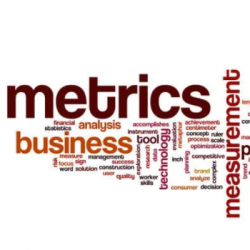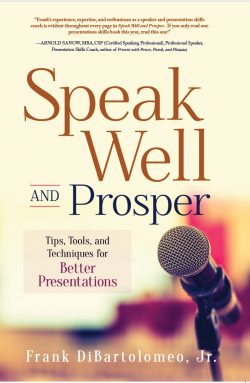Sunday, April 3, 2022

“Metrics are for doing, not for staring. Never measure just because you can. Measure to learn. Measure to fix.”
– Stign Debouwere, statistician and data scientist
No doubt you have heard the term “metrics.” Metrics are simply a way to measure, usually in numbers, how your business is performing, how you are performing in school, and whether you are getting closer to or further away from your goals. You can apply metrics to any situation where you need to measure your progress toward a goal.
Have you ever thought there are metrics you can use to determine if your speaking performance is getting better, staying the same, or getting worse?
Peter Drucker, the management consultant, said you could only improve what you can measure. I am going to bend this principle a bit.
While you are speaking, is there a way to observe your audience and get a rough idea of your speaking performance? Yes, there is.
Introducing Fuzzy Speaking Metrics.
Fuzzy speaking metrics are fuzzy because you will not be able to assign a number to a particular metric. However, fuzzy speaking metrics are a powerful way to gauge your speaking performance during and after your presentation.
Ken Blanchard, the management expert, once said, “Feedback is the breakfast of champions.”
Below are three fuzzy speaking metrics that are now your speaking breakfast. Of course, you want to be a champion, don’t you?
Audience Questions/Comments
Some speakers cringe at the thought of having to answer audience questions. Perhaps you are one of those speakers. But, my friend, if you think this way, you sabotage an essential way to increase your speaking performance.
In past articles, you have heard me say before you put your speaking thoughts together on paper or in digital form for your next presentation, you should analyze your audience. This has not changed. However, even the best audience analysis will have missing pieces of your speaking puzzle.
Audience questions give you factual, real-time, and truthful information about your audience’s thoughts, wants, and needs to know about your topic.
Your audience asks you questions for one of two reasons – either they want more detailed information or are confused about something you have said or is on your slides. Use this real-time information to adjust your presentation while you are delivering it. Remember. Your presentation is about them, not you. Cater to your audience, and you will receive commensurate accolades.
When a member of your audience raises their hand, they may have a comment instead of a question. Your audience’s comments indicate your audience’s thinking, wants, and needs on your topic – sometimes even more so than questions.
An audience member’s comment lets everyone see what that audience member thinks and feels about your topic. It may also give you an indication of what more that audience member wants in your presentation. So this is another opportunity for you to share with your audience what they want and need.
Encourage your audience to ask questions and provide comments. I’ll go further. To the extent possible, in the time you have for your presentation, encourage audience questions and comments not only at your presentation’s end but during it. Why do I say this? The earlier you know how your audience thinks and what their wants and needs are, you will have a greater chance of making it as applicable to them as possible.
So, audience questions/comments is the first fuzzy speaking metric. What about those in your audience that don’t ask questions or provide comments about your presentation? You will never become a great speaker unless you are a lifelong student of body language.
Audience Body Language
Have you ever experienced a conversation with another person and felt that what they are saying is not what they believe? You get this feeling because their body language is telling you something different. Studies show body language is the majority of communication. So let’s take body language first.
People sometimes lie through the actual words they use. Body language does not lie. For the vast majority of people and audiences you will encounter, their body language is a more accurate indication of how they think and feel than the words they are saying. Believe it or not.
Your audience will provide you with useful information by studying the body language of your audience. Below are some examples of which I think you will agree:
If some of your audience are nodding, they might not have gotten good sleep, but they are likely getting bored with your presentation. You need to change something. Ask your audience a question, show a video, or have your audience perform an exercise.
If you see your audience rolling their eyes, they are “telling” you they do not believe what you are saying. If this happens, ask your audience whether they believe what you are saying and why. If they don’t believe what you are saying, start a discussion.
If you see audience members on the edge of their seats, they are interested in what you are saying. If they are on the edge of their seats and frowning, they do not understand something you are saying. Explain your point differently and observe whether their frowns change. If they do, you have adequately explained your point. If their frowns remain, try a different way to present your point.
So audience questions/comments and body language are the first two fuzzy speaking metrics. You gather these metrics during your presentation.
The last fuzzy metric is audience evaluations.
Audience Evaluations
Audience evaluation is our third fuzzy speaker metric. This metric is less fuzzy than audience questions/comments and body language/tone of voice because you get written feedback directly from your audience.
There are two schools of thought on when audiences should complete presentation evaluations.
Have you ever attended a presentation that has just ended when the speaker asks the audience to complete the audience evaluation form before they leave? At the presentation’s end, audiences want to leave; they don’t want to fill out an evaluation form. The result is poorly completed evaluations.
I am a big proponent of distributing presentation evaluations before the presentation and, during your presentation opening, request the audience complete their evaluations as you are delivering your presentation. The result will be better evaluations, and a much higher number of evaluations collected submitted.
Let’s turn briefly to the actual evaluation form format and content. I am breaking my Rule of Three on these, but each item is essential. Below are five items you need to ensure your audience evaluation form fulfills:
Make the audience evaluation form only one side of a single page. This makes it less demanding for your audience to complete.
Have three to five simple questions like “What did you like most about this presentation?” “How can this presentation be improved?” and “What more would you have liked to see in this presentation?”
Ask your audience what topics they would like to see you deliver in the future
Ask your audience to rate your presentation content and delivery separately on a scale of one to five, with five being the best. Ensure you put criteria for what a one, two, three, four, and five mean
Ask your audience if they would like to receive your recurring newsletter; if they do, ask them to provide their full name and e-mail. Building a list of names with e-mail addresses is an excellent way to build a following through your recurring newsletter.
Audience evaluations are “gold” to you as a continually improving speaker. They are a “force multiplier” by increasing the pace of your speaking improvement
Fuzzy speaking metrics such as audience questions/comments, body language, and audience evaluations are a powerful way to gauge your speaking performance during and in future presentations.
However, there is nothing fuzzy about how they can vastly improve your speaking performance.
Make fuzzy speaking metrics your champion breakfast!
Call to Action
Encourage your audience to ask questions and make comments during your presentation
Study what audience body language and tone of voice are communicating to you and implement appropriate corrections during your presentation
Encourage your audience upfront to complete their evaluation form during your presentation; implement improvements in your future presentations.
“If you can’t measure it, you can’t improve it.”
– Peter Drucker, management consultant, educator, and author
_____________________________ Frank DiBartolomeo is a retired U.S. Air Force Lieutenant Colonel and award-winning speaker, presentation and interview skills coach, and Professional Member of the National Speakers Association. He was awarded Toastmasters International’s highest individual award, Distinguished Toastmaster because of his outstanding work in public speaking and leadership.
Frank formed DiBartolomeo Consulting International (DCI), LLC (www.speakleadandsucceed.com) in 2007. The mission of DCI is to help technical professionals to inspire, motivate, and influence their colleagues and other technical professionals through improving their presentation skills, communication, and personal presence. Reach Frank at frank@speakleadandsucceed.com and (703) 509-4424.
Don’t miss Frank DiBartolomeo’s latest book!
“Speak Well and Prosper: Tips, Tools, and Techniques for Better Presentations”

Available now at Amazon.com and BarnesandNoble.com